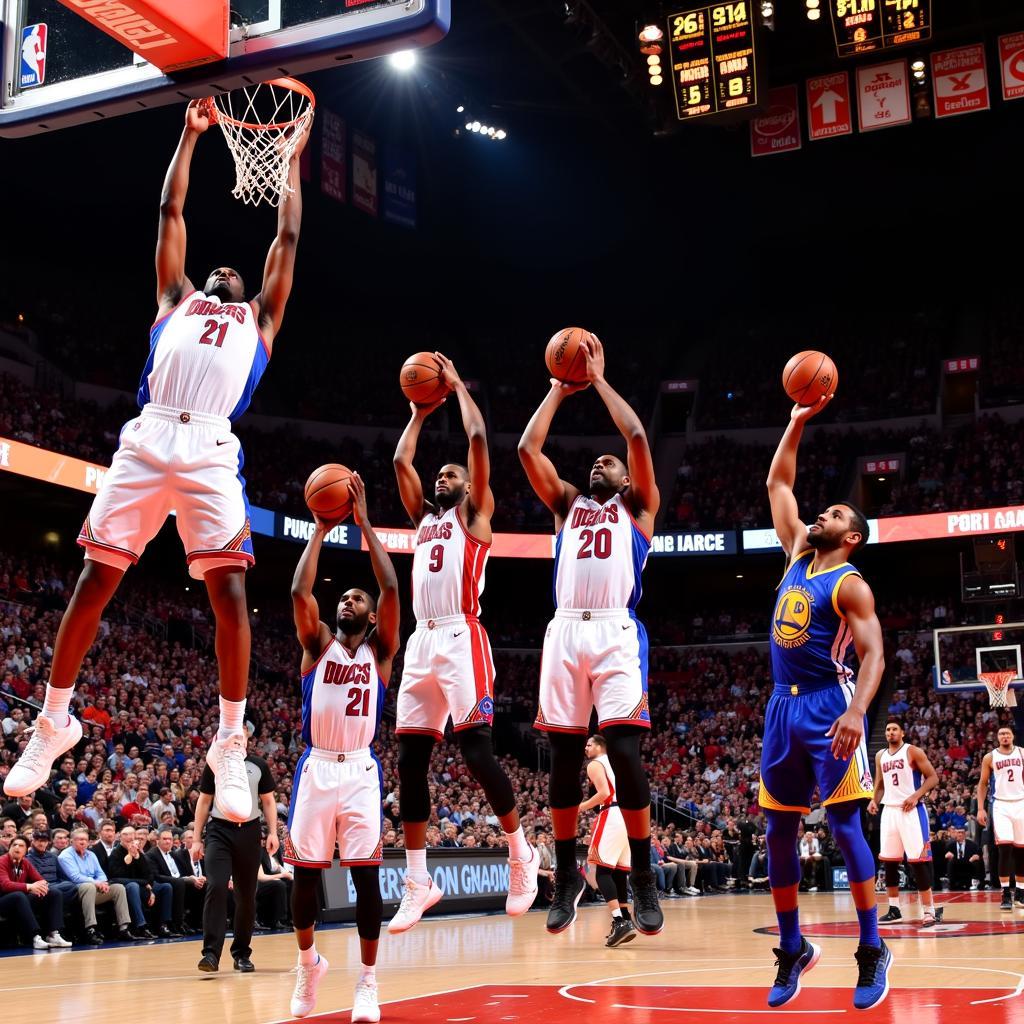Highest Jumpers in the NBA: Exploring Vertical Leap Legends
November 4, 2024The NBA is a spectacle of athleticism, and one of the most awe-inspiring feats is the incredible vertical leap of some players. Who are the highest jumpers in NBA history? This article explores the “highest jumpers in the NBA” by delving into the science, training, and legendary players who seemingly defied gravity.
The Science Behind the Soar: Understanding Vertical Leap
Vertical leap, often measured in inches, reflects the explosive power of an athlete’s lower body. It’s a combination of genetics, muscle strength, and meticulous training. Factors like fast-twitch muscle fibers and proper biomechanics play a crucial role in achieving a high jump.
While officially recorded vertical leaps are not always readily available for every player, especially those from earlier eras, we can look at anecdotal evidence, combine recordings, and analyze game footage to understand the impressive leaping abilities of some of the NBA’s greats.
 NBA Players Executing High-Flying Dunks
NBA Players Executing High-Flying Dunks
Training for Takeoff: How Players Improve Vertical Jump
Plyometrics, weight training focused on lower body strength, and core stability exercises are key components of training programs designed to enhance vertical leap. Many players also incorporate advanced techniques like depth jumps and box jumps to maximize their explosiveness. Consistency and dedication are vital for achieving significant improvements.
Specific drills, like squat jumps and single-leg hops, can target the muscles crucial for vertical leap. Proper form and gradual progression are essential to avoid injury and maximize gains.
Legendary Leapers: Highest Jumpers in the NBA History
While pinpointing the absolute “highest jumper in the NBA” is challenging, some names consistently emerge in discussions of extraordinary vertical leaps. Michael Jordan, with his iconic free-throw line dunk, is often cited as one of the greatest leapers. Other players like Dominique Wilkins, known as the “Human Highlight Film,” and Spud Webb, whose performance in the 1986 slam dunk contest is legendary, are also renowned for their incredible jumps.
More recent players like Vince Carter and Zach LaVine have continued to push the boundaries of vertical leap, captivating audiences with their gravity-defying dunks. These athletes have inspired a new generation of players to strive for ever-greater heights.
The Impact of Vertical Leap in the Game
A high vertical leap isn’t just about spectacular dunks. It also translates to advantages in rebounding, shot blocking, and contesting shots. Players with exceptional vertical leaps can alter the course of a game with their ability to control the airspace above the rim. This can lead to crucial offensive and defensive plays.
Dr. James Carter, a sports biomechanics expert, notes: “Vertical leap isn’t just about raw power; it’s also about timing and coordination. The highest jumpers aren’t just strong; they’re also incredibly precise in their movements.”
Conclusion: Celebrating the High-Flyers of the NBA
The highest jumpers in the NBA represent the pinnacle of athleticism. Their dedication to training and their exceptional physical gifts allow them to achieve feats that seem to defy gravity. While the debate over who truly holds the title of “highest jumper in the NBA” may continue, one thing is certain: their incredible athleticism continues to inspire and entertain basketball fans worldwide.
FAQ:
-
How is vertical leap measured? Typically, vertical leap is measured using a Vertec or similar device that measures the difference between a player’s standing reach and their maximum reach while jumping.
-
What are some common exercises to improve vertical leap? Plyometrics, squats, and deadlifts are common exercises for increasing vertical leap.
-
Does height affect vertical leap? While height can be an advantage, shorter players can have impressive vertical leaps due to factors like muscle strength and technique.
-
Who is considered the highest jumper in NBA history? While no definitive record exists, Michael Jordan, Dominique Wilkins, and Spud Webb are often mentioned among the highest jumpers.
-
Is vertical leap the only factor in dunking ability? No, factors like arm length, timing, and coordination also play a crucial role in dunking.
-
How can I improve my vertical leap? Consistent training, focusing on plyometrics, strength training, and proper technique, can help improve vertical leap.
-
Are there any risks associated with training for vertical jump? Yes, improper training can lead to injuries. It is important to prioritize proper form and gradual progression.
If you need further support, please contact us at Phone Number: 0396443476, Email: [email protected], or visit our address: 23 Tháng 3, Đắk Nia, Gia Nghĩa, Đắk Nông, Việt Nam. We have a 24/7 customer support team.